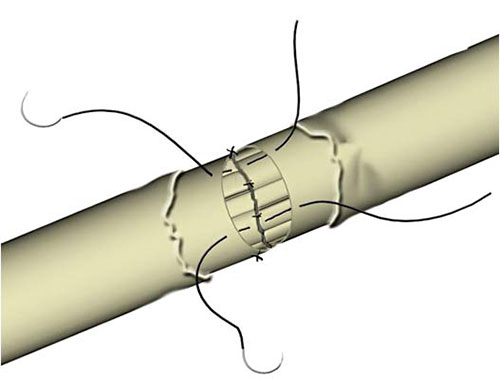Nerve repair
Neurotmesis refers to the complete division of a nerve and recovery in this situation depends on surgical repair. Successful healing depends on a number of factors including the patient's age; the level of the lesion, the more proximal having a worse prognosis; the severity of the injury and the type of nerve that is injured, with mixed nerves, such as the median and ulnar, having a poorer prognosis than a predominantly motor nerve, such as the radial. Primary nerve repair should be confined to a clean nervve cut and an otherwise limited injury, when an experienced surgeon is available with the appropriate instrumentation. Otherwise, the nerve ends should be identified, orientated and, where possible, drawn together with 2 or 3 inert sutures, for later or secondary repair.
Anaesthesia
General or regional, using a pneumatic tourniquet to obtain a bloodless field.

Procedure
Magnification by loupes or an operating microscope is essential.
- In primary repairs, about 1-2mm of nerve ends is trimmed with a sharp blade on a firm surface.
- In a secondary repair, healthy nerve is identified on either side of the scarred area, and then followed into the injured site. The neuroma is then amputated with a sharp blade.
- A standard epineural repair involves the drawing together of the two ends with stay sutures placed in the circumferential epineurium.
- Correct nerve alignment is provided by orientation of the fascicles in the nerve, and of the blood vessels on its surface.
- A minimal number of 8/0 or smaller synthetic non-absorbable sutures are placed in the epineurium to approximate the nerve ends.
- There should be no tension after the repair and large defects require nerve grafting (using the sural or saphenous nerve).
Closure
Routine in layersMain Postoperative Complication
Poor or imperfect nerve recovery. The success of the recovery reflects the quality and accuracy of the repair, which, in turn, depends on the skill and experience of the surgeon.
